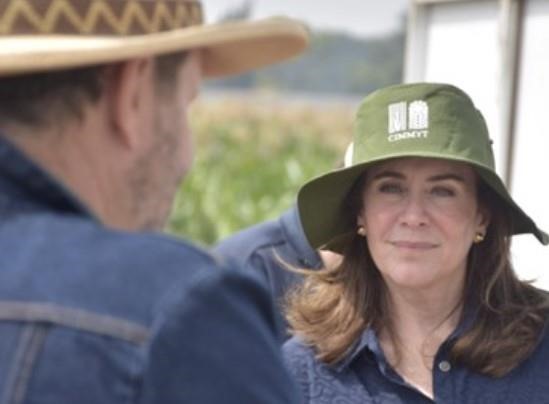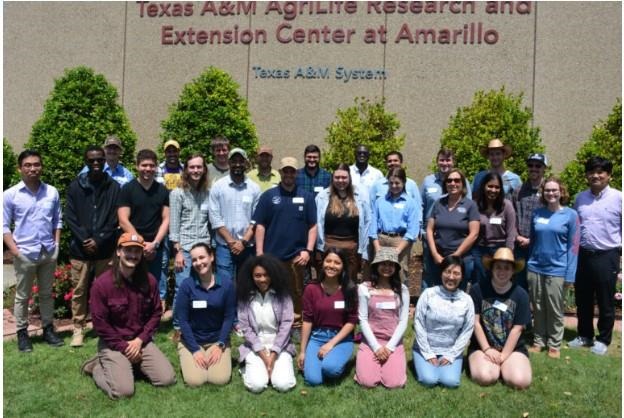Texas A&M AgriLife is leading the creation of a UAS-Hub and connection with a cloud-based database for the project, which brings together public wheat breeding programs in 22 institutions across the U.S. The team will coordinate technical aspects of drone data collection and submission for all the breeding programs.
“Processing big data is a bottleneck for many programs, but Texas has made a lot of progress in this area, and the processing is automated,” said Amir Ibrahim, Ph.D., Bryan-College Station, Texas A&M AgriLife Research wheat breeder and professor in the Department of Soil and Crop Sciences, Bryan-College Station. Ibrahim serves as AgriLife Research’s lead on WheatCAP.
Student involvement important to future of public wheat breeding
A large component of the project is to involve students in research. Students from across the U.S. are being trained in all aspects of traditional plant breeding and equipped with experience in and knowledge of the newest UAS technology to collect plant height, canopy cover, canopy volume and vegetation indices for wheat.
“Standardized high spatiotemporal resolution data collected over the growing season at multiple locations will enhance our understanding of growth dynamics and genotype by environment interactions,” Ibrahim said. “At this point, some programs will send raw data, and others will be more advanced.”

Ismail Olaniyi, graduate research assistant, Purdue University, helped with the instruction of students during the Texas A&M AgriLife-led UAS phenomics workshop in Amarillo. (Photo courtesy of Jinha Jung)
Twenty-five students from 19 universities attended the first training in Amarillo, where the purpose was to train as many as possible with the basics of UAS high-throughput phenotyping.
Katherine Running, WheatCAP education coordinator from North Dakota State University, said this is the first phenomics workshop for the students. They will attend a genomics workshop later in Raleigh, North Carolina.
“The students came for hands-on data collection and analysis training,” Running said. “They will take this training back to their own research projects now. We hope to give them better tools to collect more data and conduct stronger data analysis, which, in turn, informs the breeding efforts that develop better-adapted wheat for their areas.”
One student reported in a post-training survey that “it touched on basic and very important steps to collect high-quality UAS data. Also, I learned some great techniques to process most of that data I acquire, which was my goal in coming to this workshop.”
Hands-on training
Most of the students at the Amarillo training were novices, said Shannon Baker, AgriLife Research certified pilot and a program manager in the wheat breeding program, Amarillo. Only about 15% had a significant amount of experience.

Students from public wheat-breeding programs across the U.S. participated in a Texas A&M AgriLife-led UAS training in Amarillo. (Texas A&M AgriLife photo by Kay Ledbetter)
And while the biggest issue certainly was data processing and how to manage the massive amounts collected by UAS, Baker said there was a great interest in flying the UAS as well.
“We presented the training in the order that data collection occurs,” she said. “We detailed how to lay out field trials for data collection, preparing the UAS equipment and planning the mission in the classroom before heading to the field. In the field, we stressed the importance of ground control points and demonstrated the recommended equipment.”
Baker said they flew two multispectral sensors on two separate UAS, as well as an RGB sensor for a total of three flights.
The second day of the training dialed in on uploading data to the UAS HUB, how to orthomosaic the images and delineate plot boundaries to give students experience in extracting data that they can take back to their labs and analyze their own data.
“The most complex step was walking through extracting data from the delineated plots,” she said. “We finished with a discussion of what traits interest breeders and what to focus on when returning to the lab.”
The last session ended with a discussion led by Jackie Rudd, Ph.D., AgriLife Research wheat breeder, about how the Texas A&M AgriLife wheat breeding program integrates UAS data into the line advancement and variety development decisions.
“Grain yield and bread-making quality are still invaluable for variety selection, but the UAS data give us new insights into growth rate and stress response, assuring that new varieties will meet producer expectations,” Rudd said.
Texas A&M AgriLife strong
Other AgriLife Research team involved in the project and the training were Shuyu Liu, Ph.D., geneticist, Amarillo; and Juan Landivar, Ph.D., center director, Mahendra Bhandari, Ph.D., remote-sensing crop physiologist, Jose Scott, engineer/programmer, and Francisco Gaona, research assistant, all at the Texas A&M AgriLife Research and Extension Center in Corpus Christi.
Also on the teaching team was Jinha Jung, Ph.D., assistant professor of civil engineering, Purdue University, who was formerly an AgriLife Research scientist in Corpus Christi and a key part to building the data analysis and interpretation part of the Texas A&M AgriLife UAS pipeline. He was joined by Ismail Olaniyi, graduate research assistant, Purdue University.
Source : tamu.edu